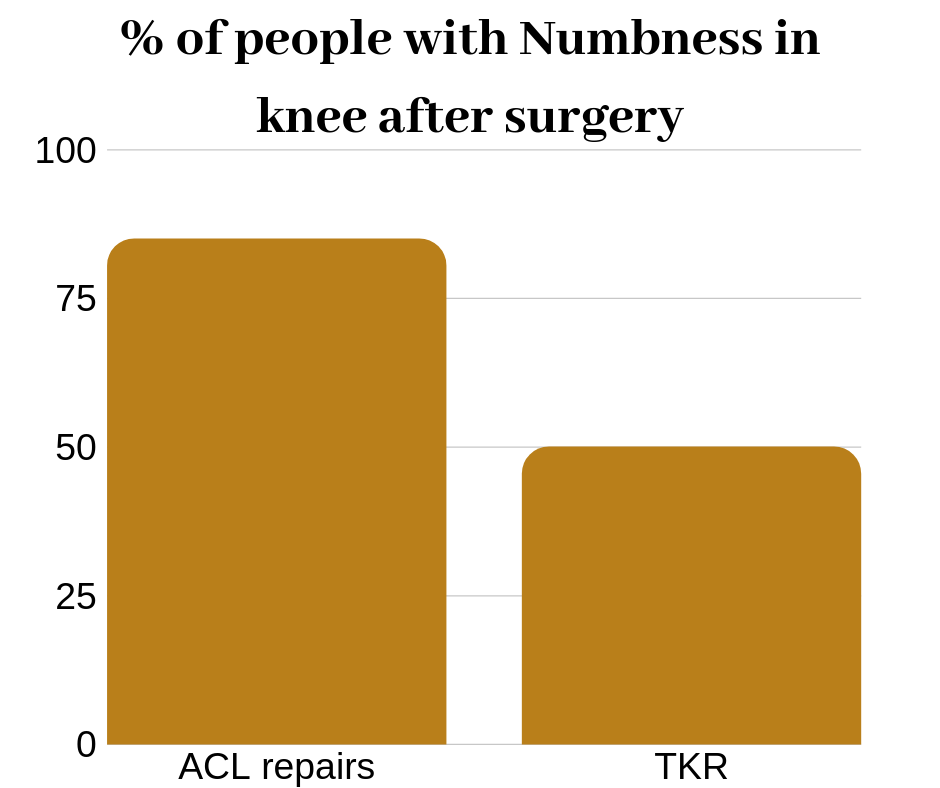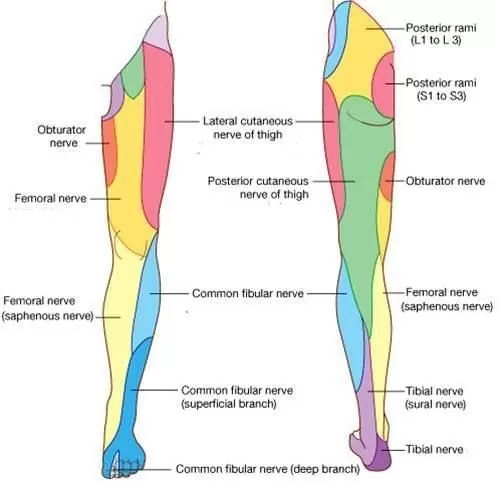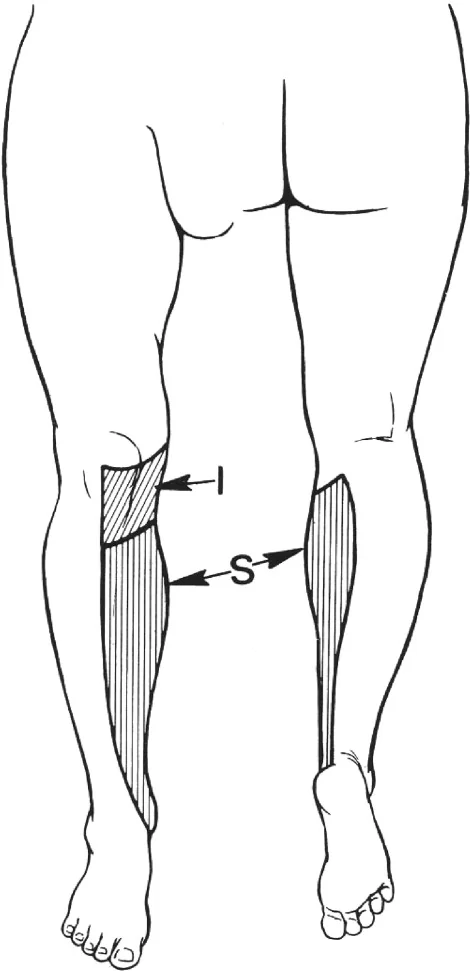Numbness in knee or leg after knee surgery? Causes, treatment and more.
Knee numbness after surgery is very common with up to 85% of surgical candidates experiencing some form of numbness post operation.
Even with this high prevalence, the causes and long-term outcomes of knee numbness after surgery are not always explained.
Prefer to skip ahead?
- Causes of knee numbness after surgery
- How common this occurs
- If knee numbness will get better and how long it can take
- If you should be concerned about burning pain
- Causes for numbness down the whole leg
This article will cover knee numbness in detail to give the best understanding of what actually causes numbness, and what the longer term outcome of your knee numbness.
Prefer to watch the video? Check this blog in video format here:
What causes numbness in the knee after surgery?
Surgery always involves cutting tissue open to expose the parts that need to be repaired or taken out. Any time you cut into tissue, there is a small risk that nerves can be cut as well.
Our body is full of nerves, and like arteries and veins, they can be either big or very small. Some nerve fibres transmit motor signals which contract muscles, other nerves are responsible for sensation.
Nerves start from the brain and spine bundled into big trunks called nerve roots. Further away from the spine, nerves branch off, becoming smaller as they go to specific areas of the body.
Small nerves are easily missed by surgeons, especially if they perform the surgery via arthroscopy (keyhole surgery). Numbness can arise when a small nerve is accidentally cut or stretched.
Both ACL and total knee replacement surgeries involve incisions at the front of the knee. The site of both incisions is very close to a nerve which is quite small and easy to miss.
This nerve, called the inferior branch of the saphenous nerve, travels from the inside to the outside of the knee. It provides sensation for a patch of the knee shown in the below picture (the ‘I’):
The ‘I’ in the picture is the area of sensation supplied by the inferior branch of the saphenous nerve. The ‘S’ is the area of sensation supplied by the saphenous nerve.
Let’s go into either surgery to see what happens:
Total knee replacement:
The surgeon will cut straight through the front of the knee to have full access to the shin bone and thigh bone. This incision is essential as they need open access to both ends of the bone to cut and replace the knee joint.
Due to the proximity of the inferior branch of the saphenous nerve, there is a chance that this nerve will be cut as well.
During total knee replacement surgery there is a much larger incision. Because of the large incision it is easier to identify smaller nerves. This explains why there is a higher chance of knee numbness with keyhole surgery.
ACL surgery:
As surgical techniques progress, it’s now standard to have an arthroscopic repair (keyhole surgery) for ACL injuries. One of the draw-backs of going into the knee through a very small hole, is the surgeon is unable to visualize every structure as they go.
The key-hole surgeons use to access the hamstring tendon, for the ACL graft, is in very close proximity to the inferior branch of the saphenous nerve. The nerve can often be cut or stretched as they place a tool through the incision when collecting the hamstring tendon.
How common is numbness in the knee after ACL surgery or knee replacement surgery?
The symptoms of numbness post knee surgery are surprisingly common! Let’s jump in and see exactly how many people end up with numbness after surgery.
The below picture graphs percentages of knee numbness after surgery. This is taken according to available literature on how many people will have numbness after ACL surgery or a total knee replacement.

You can see that 85% of patients experience numbness after arthroscopic ACL repairs, compared to 50% of patients who experience numbness after a total knee replacement.
This is probably due to what was previously discussed about the surgeon not being able to visualize structures within keyhole surgery.
Does numbness in the knee go away after surgery and how?
The above percentages spoken about were taken 10 years after surgery. This means that even if there is a portion of people where numbness will improve, it will most likely stay.
Some people will experience transient numbness which does improve, and it can even completely resolve. Let’s talk about why that might be:
Nerves are bundles of long axons, kind of like rope. All these individual axons are wrapped in a sleeve to keep them in one package. You will also find little blood vessels that help to transfer nutrients and keep the nerve alive.
Electrical signals are passed down through the nerve axons and this allows for motor function or sensation.
During surgery the nerve will either be completely cut – or just stretched.
If the nerve is completely cut, either end will slowly grow to try and find each other. If the two ends meet, the nerve will likely re-join, and therefore sensation will return.
Keep in mind, nerves grow at a rate of 1-4mm/day. Sensory nerves are more resilient and therefore can recover after months or years in some cases.
If the nerve is stretched during the surgery, there’s a much better chance sensation will improve. During the stretch, the outer wrap will squeeze down on the spindles and cut off the blood supply inside the nerve.
After the stretch the blood supply returns and the nerve can begin to regenerate.
An example of this occurring is sleeping on your arm during the night. You might wake up with a numb arm, but as blood supply is returned, so is the sensation. This will explain why some patches of numbness will improve with time.
How long can it take for numbness in my knee or leg to go?
As mentioned previously, it is unlikely that sensation will return if the nerve was cut. So, in majority of cases the sensation is unlikely to fully return, although it can happen.
Most people will experience a return in some or part of their sensation. This is probably because the nerve was simply stretched through the surgery. Or other nerves have grown and compensated for the other.
If the nerve is purely stretched, experts would suggest that the nerve should recover in 6-12 weeks.
My advice, is to watch the site of numbness for signs of improvement for the first 3 months. If there is no change in sensation it is likely that the sensory nerve was cut during surgery and any further progress would be minimal.
Some of you may ask if the nerves can simply be repaired since they were cut. Although the concept is sound, the nerve in question is so small that repair would be extremely difficult.
On top of this, there is always a risk of infection which outweighs the benefits of returning the patch of sensation loss.
Thankfully, most people report that it doesn’t usually interfere with their quality of life.
Even still, it’s something that is worth mentioning to patients as one study revealed most patients were either unsure or not told about numbness post-surgery.
Should I be worried about burning pain after surgery?
Burning pain can be associated with either nerve damage or an infection in the knee.
These are some of the signs to look out for with an infected knee:
- Burning pain
- Swelling in the knee
- Redness in the knee, or red streaking down the leg
- Fevers or chills
- General feeling of being unwell
If you have some of these signs, you will need to consult a medical professional to make sure you don’t have a knee infection.
If there is none of the above signs, then it’s usually an indication that a nerve is still inflamed, probably because of surgery. When a nerve is stretched, often fibres can be torn resulting in a small amount of nerve damage also called neuropraxia.
Neuropraxia results in swelling and inflammation in the nerve as it attempts to repair the damaged fibres. While the nerve is inflamed it is very common to have altered sensation such as pins and needles, numbness, pain or a cold feeling.
Nerves are generally good at healing themselves and in 6-12 weeks you should notice the pain will improve. There are ways to aid recovery if the nerve is particularly painful:
How can I improve burning pain or numbness after knee operation?
The aim of treatment is to reduce pain and resolve the inflammation within the nerve. There are a few ways you can tackle this:
- See a doctor for advice on appropriate pain medication.
Pain medication can target pain relief via a few different mechanisms. There are some pain killers that will work for you and others that won’t be as affective.
You can have certain pain killers that are targeted towards nerve pain such as gabapentin and lyrica. It is important to consult your doctor before taking any pain medication to check for side effects.
- See a physiotherapist for appropriate exercise prescription
Physiotherapy can help settle the nerves with appropriate exercises. The aim of these exercises is to help reduce the amount of swelling within the nerve and the knee.
These exercises will help to gently glide the nerve without straining it, which helps to pump the fluid out of the nerve. This same principle is used by your body to pump fluid through veins.
Thanks to our current technology we can now benefit from online physiotherapy! So you can receive treatment without even leaving your home. If you need convincing, check out our blog on 3 reasons why you should choose online physiotherapy.
There is the option of injecting local anaesthetic into the joint to settle the nerve. This can sometimes help to relieve pain and inflammation within the nerve.
Remember if the nerve is painful, over time this should be settling down. If there is no change past a couple of weeks, then consult your GP to check for other causes.
What about numbness down the whole leg or into the foot after surgery?
In rare cases, there is potential for larger nerves to have been damaged during surgery.
This article found that 23% of patients with nerve injuries had numbness down the leg in the area shown below.

This pattern of numbness results from damage to the sartorial branch of the saphenous nerve. Which is a slightly larger sensory nerve which supplies sensation to a bigger area.
Every persons nerves will be slightly different, so these body maps are good for a reference, but they will not exactly apply to everyone.
If the area of your leg numbness is largely outside the cream coloured section of the picture (saphenous nerve), it would be advisable to seek medical advice to get this checked.
As previously discussed, if your nerve was cut in surgery, the chances of a full recovery are slim. However, you may just have a neuropraxia and in this case, you will get most sensation back.
Thankfully sensation changes doesn’t usually lead to strength changes as the signals come from different nerves. So there will be minimal chance of numbness leading to your knee giving way or other symptoms of weakness. If giving way of the knee is occurring, it is advisable to also seek medical advice.
The bottom line:
Numbness in your knee and leg after surgery is very normal. The majority of cases will have continuing numbness; however, some will improve and even fully recover.
If you are experiencing burning pain in the knee, there are ways to improve this including physiotherapy and pain killers.
Other articles of interest:
How to stop running with heel pain
Best shoes for Achilles Tendonitis
Best shoes for Plantar Fasciitis in 2021
Keys to recovery post patella dislocation
How so solve heel pain in the morning
Plantar Fasciitis – Symptoms, stretches and exercise
How to calf raise with superb technique. Seated/standing variations.
References:
Höke A (2006) Mechanisms of Disease: what factors limit the success of peripheral nerve regeneration in humans? Nat Clin Pract Neurol 2(8):448-54. DOI: 10.1038/ncpneuro0262
Inderhaug E, Strand T, Solheim E (2015) The impact of sensory deficits after harvesting hamstrings autograft for ACL reconstruction. Knee Surg Sports Traumatol Arthrosc. 23(4):1060-4. doi: 10.1007/s00167-014-2871-2
Jariwala AC, Parthasarathy A, Kiran M, Johnston LR, Rowley DI (2017) Numbness Around the Total Knee Arthroplasty Surgical Scar: Prevalence and Effect on Functional Outcome. J Arthroplasty. 32(7):2256-2261. doi: 10.1016/j.arth.2017.01.057
Sanders B, Rolf R, McClelland W, Xerogeanes J (2007) Prevalence of saphenous nerve injury after autogenous hamstring harvest: an anatomic and clinical study of sartorial branch injury. Arthroscopy 23(9):956-63. DOI: 10.1016/j.arthro.2007.03.099
Frequently asked questions:
What is the cause of knee numbness after surgery?
Usually the cause of numbness post surgery is due to a nerve either being cut or stretched throughout the course of the operation. Some nerves are extremely small and difficult for surgeons to visualise, so there is a chance these can be cut.
How common is knee numbness post surgery?
Knee numbness is surprisingly common post surgery. Depending on the surgery, the rates of knee numbness range from 50% up to 85%.
Does knee numbness go away?
This depends if the nerve was either cut or stretched. If the nerve was simply stretched, then there is a good chance sensation will return. If the nerve was cut then sensation will be less likely to return.
How long does numbness take to resolve?
Experts would suggest numbness should resolve in 6-12 weeks if it is going to get better. This also depends on whether the nerve was cut or stretched.
Should I be worried about burning pain?
Burning pain can be a result of infection in the joint, or simply a sign of inflammation in the nerves. If the burning pain is accompanied by things like swelling, fevers or chills or just a general feeling of unwell then see a doctor immediately.

